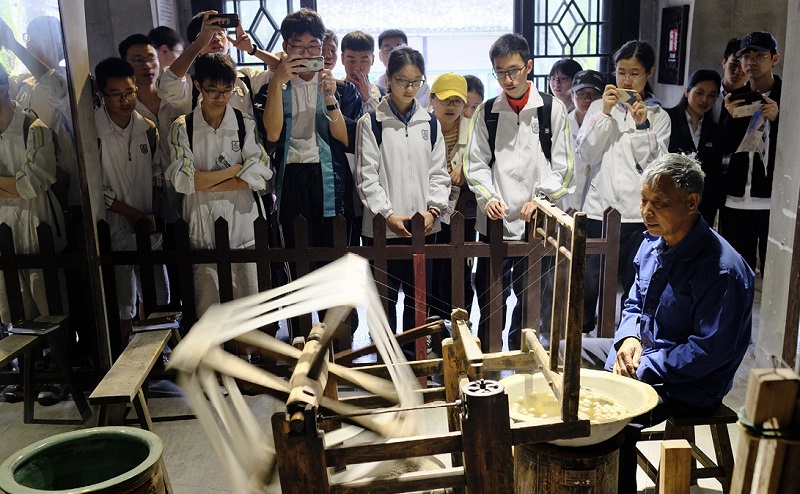
Gu Mingqi, a national intangible heritage inheritor, is showcasing silk reeling techniques to a group of visiting students on April 19, 2019.
Jili silk is a type of silk produced in Jili Village, Nanxun Town, Nanxun District, Huzhou City in east China’s Zhejiang Province. Jili Village has been producing silk since the village was established in the late Yuan Dynasty (1271-1368). Jili silk is characterized by being stretchy, soft and fine with an even thickness and shiny white color. With these features, Jili silk is widely recognized in China and across the world.
In the mid-Ming Dynasty (1368-1644), this silk became more renowned for being one of the materials used to make the emperor’s most exquisite robes. In the Qing Dynasty (1644-1911), the government-administered weaving bureau used to purchase a large amount of Jili silk each year. In 1851, Shanghai merchant Xu Rongcun took Jili silk to the first World Expo held in London, where the fabric won two top awards. In 2011, Jili silk was included in the list of China’s national intangible cultural heritage items.
The cultivated silkworm used for Jili silk is called the Lianxin, literally meaning lotus seed. In Jili Village, wooden reeling tools were designed specifically for Jili silk. The silk making technique was traditionally passed down by female members of a family. In addition to being used for clothes, quality Jili silk can also be made into strings for Chinese zither, or guqin, a plucked seven-stringed musical instrument, or used as materials to restore ancient silk scrolls.
In the rigorous process of making Jili silk, selecting cocoons is the first step. Spotted, dented, or thin cocoons are regarded substandard and unsuitable. The cocoons need to be boiled in hot water to remove any impurities and some jelly-like substance. Workers then manually extract the silk filaments from the cocoons, a process which requires great patience, as the thread is thinner than a human hair. A cocoon from the Lianxin silkworms can generally produce a 1,400-meter-long filament of silk, with the maximum length reaching 1,800 meters.
The final step is reeling and throwing. The silk making equipment is set in motion by a worker using foot pressure. It takes eight cocoons to produce one roll of spun silk ready for sale.
Since the emergence of the reeling machine, the hand-reeling industry began to decline in the rural areas of Nanxun. To protect this age-old skill, a traditional hand-reeling workshop and a demonstration center were set up in the old town of Nanxun, showcasing the charm of this traditional skill to visitors.
Today, through genetic screening technology, inheritors of Jili silk making can breed silkworms producing filaments in natural colors, such as light yellow, golden yellow and light pink. The step of dyeing thus becomes unnecessary in some cases. Making use of the optical properties of Jili silk, scientists are experimenting with innovative applications of the fabric. For example, they are extracting fibroin from cocoons and using it as a material to make hard disks for data storage. The efforts of combining the Jili silk making wisdom with modern technology are giving a new life to the ancient Chinese handicraft in the modern era.